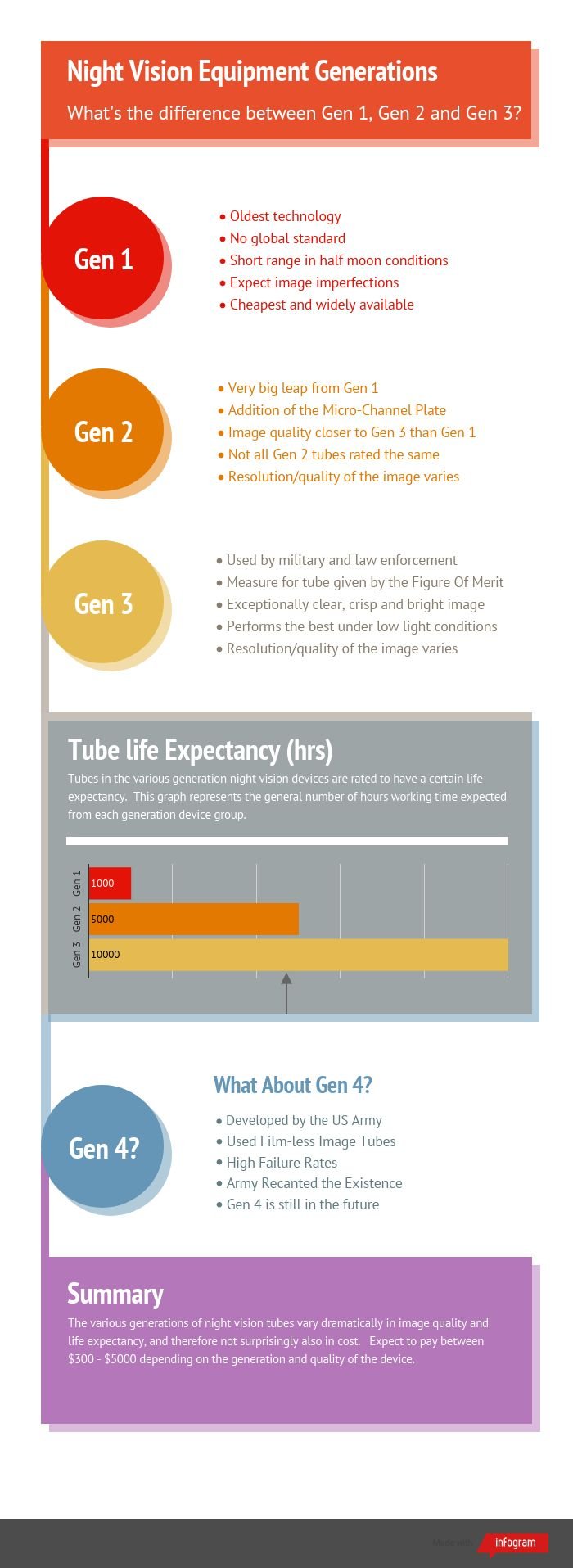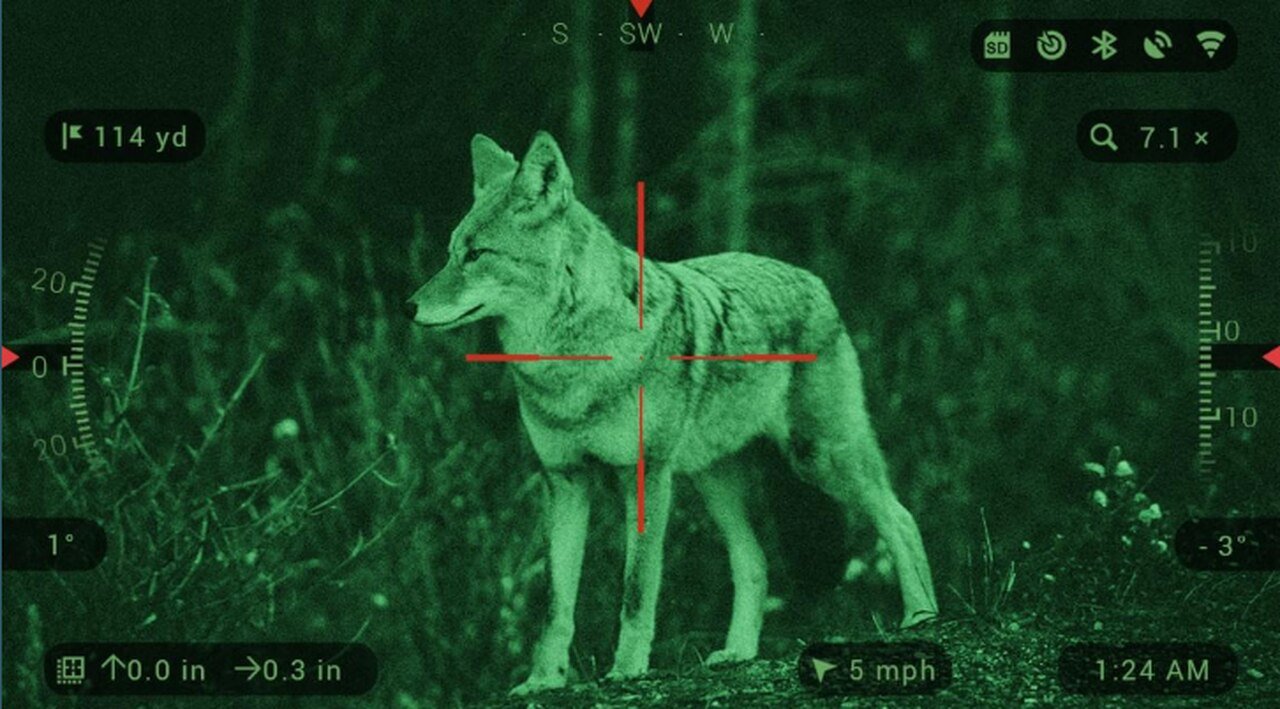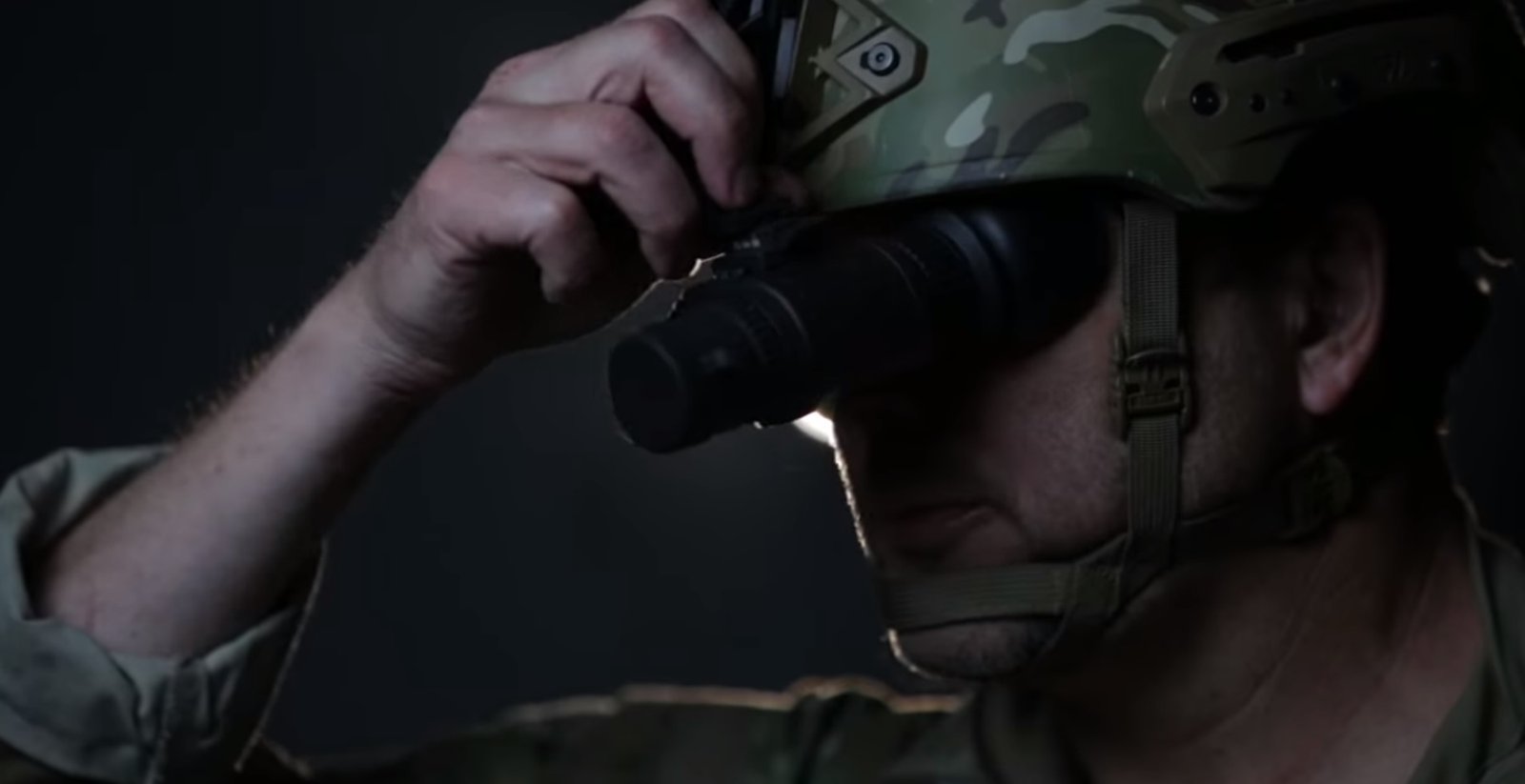PointOptics is reader supported. We earn an affiliate commission if you buy through our links . Learn More.
Over the years, it has come to our attention that there are many misconceptions and much misinformation regarding the use of night vision equipment. Some of it comes from watching the outrageous things that actors do with ‘supposed’ night vision in movies, and some of it comes from listening to fellow hunters who are not in the know when it comes to night vision.
That prompted us to write this article on the different night vision gear and devices that are out there in the hunting marketplace. This article will give you a general overview of how night vision works and talk about some of the most popular night vision gear and devices.
Here is some general information on night vision technology that may prove useful when shopping for a new piece of night vision gear or a night vision device.
Difference Between Gen 1, Gen 2, and Gen3 Night Vision Equipment

As you shop for night vision equipment for hunting, you will notice the word ‘generation’ is often found in a piece of night vision equipment’s description. Night vision gear and devices that use image enhancement technology are classified as being generation 1, generation 2, generation 3 or generation 4 image-intensifying equipment. The higher the generation the more advanced that piece of night vision gear or device is.
Most of what is found in the hunting marketplace is generation 1 or 2 classified image-enhancing equipment. This is because generation 3 and generation 4 classified nighttime imaging enhancement devices are out of most people’s reasonable night vision budget range. Generally, even generation 2 classified nighttime imagining devices are 3x to 4x more expensive than generation 1 type night vision equipment.
Generation 1
Gen 1, as could probably be guessed, was the initial generation of night vision and was developed already back in the 1960s. At the time, however, few could have guessed that night vision technology would be readily available through online retailers to the public for an affordable price. The Gen 1 night vision technology makes use of IR illumination. The shortfalls of Gen 1 lie in the technology itself. While it remains the most affordable technology, Gen 1 falls short of following generations regarding the quality of the visuals.
Generation 2
Despite generation 2 technology being developed just over a decade later, the technology itself saw some huge changes in how it was being used and the massive increase in quality developed with the 2nd generation. Unlike Gen 1, Gen 2 provides night vision functionality without requiring IR illuminators.
In the second-generation night vision technology, we also began to see the use of micro-channel plates (MCP) in conjunction with S-25 photocathodes. This new technology allowed for more light amplification and less image distortion from high-light sources. The idea here was for the technology to reduce high-intensity light and increase low-lit areas.
The improvements were exponential between generations, and much like with the USB technology of a computer, the quality variation found between generations is massive. Second-generation night vision technology is often used by law enforcement and professional hunting. While the 3rd generation is of an even higher standard, Gen 2 will often blend reasonable affordability with image quality.
Generation 3
It was then another 20 or so years before the development of the Gen 3 night vision technology, and with the Gen 3 came some exciting technological changes from a hardware perspective. Micro-channel plate (MCP) was retained in the gen 3 (this time using an ion barrier coating for longer life). There was also now the introduction of a more effective photocathode which makes use of gallium arsenide. This new addition helped increase image quality in the generation, and Gen 3 allows for some impressive results with low light. Unfortunately, this new technology doesn’t come cheap, and you certainly won’t be finding Gen 3 technology available at your local store.
Generation 4 / 3+
This generation is sometimes called Gen 4 or Gen 3+, but the most accurate term would still be GEN-III OMNI-VI/VII. This project is still in development through the US Army and brings with it some fascinating changes to how night vision technology operates. Historically, night vision has not been very reactive to the surroundings; with this new generation, a power supply regulates the voltage of the photocathode. This allows it to adapt to environmental conditions and provide a better experience for the user, especially when moving between environments with variations in how light or dark the surroundings are.
In Gen 3, there were some issues with the ion barrier, causing more distortions from high light sources. This was a trade-off that was made to lengthen the Gen 3 lifespan. The Gen 3+/Gen 4 technology in development removes or lessens this barrier to ease distortions and noise, but this isn’t without negating the lifespan of the new generation.
While we will likely see this move to a consumer market at some point in the future, this may still be decades away.
This generation of night vision can be thought of more as an extension of Gen 3 than its new generation. New advancements may change this generation of night vision completely before its available for consumers.
Types of Night Vision Technology
Two types of so-called ‘night vision’ technologies are used on the gear and devices to aid you when trying to see objects at night.
Thermal Imaging
Thermal imaging lets you view objects at night by identifying the heat signatures from an animal or person. The warmer the object, the more it sticks out and contrasts with the cooler foliage and the other objects surrounding it. Using an internal thermograph, a thermal imaging device changes the emitted heat signature coming into the lens into a more discernible temperature pattern for viewing.
Image Enhancement
Image enhancement does just what its name implies. It takes even the smallest amount of available light and intensifies it so you can see images more clearly at night. This technology uses reflected light instead of an object’s thermal signature. Most of the nighttime hunting equipment in the sports marketplace uses image enhancement night vision technology.
System Light Gain
When shopping for any image-intensifying nighttime viewing device, you need to pay attention to what is known as its ‘light gain’ too. Light gain is the intensity level of the light you will see when looking through any image-intensifying device.
You want your night vision equipment to have the most light gain possible, but you must also be aware of the tradeoff. The greater your magnification with any image-intensifying equipment, the lower your available light gain will be (unless you use sophisticated and expensive nighttime image-intensifying devices).
Here, you can find more information on night vision terminology and how it works.
The Main Types of Night Imaging Gear and Devices
Here are the most popular night vision gear and devices for nighttime hunting, night trekking, and other nighttime activities.
Night Vision Goggles
Goggles are a top choice for many night vision users. This is because they are very easy to wear and use. Most can just be flipped up and down as you need them. That makes them pretty convenient to use, to say the least. They must be worn with some halo device to hold them on your head or attached to a helmet.
Night vision goggles are especially useful if you hunt at night because they allow you to keep both hands free so you can shoot. Most models of night vision goggles come with little or no magnification capability.
Even though night vision goggles receive light photons in many colors, once these photons are magnified, the light images appear to the user in a greenish glow. This is because specially chosen phosphors on their screens are purposely put there to generate images in that color. It’s much easier to look at these green-tinted images for longer because human eyes are more sensitive to that color.

One question we always get is whether you can see with image-intensifying night vision goggles even when it’s dark. The answer to that question is no because no traces of light can be intensified to generate an image when looking through them. Being engulfed in thick black smoke would be an example of when image-intensifying night vision devices would be useless.
There are three main types of night vision goggles:
1. Monocular goggles
This goggle type has a single eyepiece that pulls down over just one eye. They take a little getting used to because you lose depth perception when viewing objects through just one eye. The biggest advantages of using this type of night vision goggles are that they are the lightest type and are usually the least expensive, too.
2. Bi-ocular goggles
Here is a type of night vision goggle with two eyepieces converging into a single lens. This two-eyeiece design adds to the comfort of looking through them and adds to the goggle’s weight. Once again, these goggles tend to distort depth perception since it has just a single lens.
3. Binocular goggles:
These night vision goggles feature both two eyepieces and two lenses. This tends to improve depth perception when using them greatly. It also adds to the comfort of using them when looking through the lenses. These are by far the heaviest type of night vision goggles and are usually the most expensive. If you are planning on moving around a lot when using your night vision goggles, they are the preferred type of night vision goggles to wear.
Night Vision Binoculars
Like most night vision goggles, so are our night vision binoculars, usually image-intensifying type night vision devices. These types of night vision devices are handheld, like regular binoculars. You look through them using both eyes, and they offer good depth perception since they have two eyepieces and two lenses.
They work the same way as night vision goggles, but they usually have a slight magnification capability (usually limited to the 2x range, but there are some exceptions). A pair of night vision binoculars’ slight magnification ability does not come close to the long-distance magnification capabilities of most daytime long-distance viewing equipment. They will, however, allow you to see a generous distance even in very low light conditions.
Because of their slight magnification capability, night vision binoculars are not a good night vision choice to use while you are on the move. They work very well when observing objects at night from a stationary position.
Night Vision Monocular Devices
Unlike night-vision binoculars, night-vision monocular devices have only one eyepiece and one lens. They are a handheld nighttime viewing tool; you only use one eye when looking through them. Like their monocular night vision goggle counterparts, monocular night vision devices tend to distort depth perception because you only use one eye when looking through them.
The big advantage of using a monocular night vision device instead of night vision binoculars is that they are lighter and usually more compact. This makes them easy to bring along as you hunt or move about at night.
Some night vision monocular devices have become very sophisticated as of late, too. Not only do they enhance your ability to see at night, but they have other bonus capabilities as well. Some advanced monocular night vision models will do such things as take still photos, shoot video bursts, and act as a normal daytime monocular viewing device, too.
Thermal Imaging Scopes
Thermal imaging scopes work by receiving an object’s heat signature and then converting that signature into a more viewable pattern for identification. The specially-made lens on the device works in the infrared light spectrum. Thermal imaging scopes can be weapon-mounted or used as a handheld nighttime viewing device.
The big advantage that a thermal image scope gives you over image-intensifying nighttime viewing devices is that it will still work in pitch-black conditions, regardless of the time of the day or night. This includes the ability to see through smoke and other conditions limiting or eliminating the ability of image-intensifying nighttime viewing gear to work.
Trail Cameras
Perhaps no hunters’ aid has helped hunters save more time and effort than trail cameras. They are especially useful when it comes to helping scout for games. What used to take numerous hours of painstaking effort for a hunter now only takes a small fraction of that time and effort. Trail cameras are on the job 24/7 and will give users a very good idea of what game animals regularly visit a particular area. They also make great remote security cameras.
Trail cameras work in one of several different ways. Users can set them to take a photo when their motion sensors are activated, take a photo on a time-scheduled basis or even have a time-lapse photography mode. Most trail cameras can shoot short video bursts during the day and take both day and nighttime photos. Nighttime photo taking is a must for any trail camera used for game scouting because deer and other game animals are more active at night.
For nighttime photo taking, trail cameras use a sophisticated flash mechanism. The range of this flash is often in the 60’ to 80’ range. The two most popular flash types are black infrared and low-glow infrared flashes. With black infrared, the flash is unseen by the naked eye in both humans and animals. Low-glow infrared flash is visible if you look in the trail camera’s direction when it flashes. Neither one is likely to spook the targeted animal when it flashes.
Wireless Trail Cameras
Trail cameras that use a cellular service provider are usually 3x to 4x more expensive than regular trail cameras, but they offer one big advantage. You do not have to walk to where the trail camera is placed to see the photos that it has taken. The photos on its SD card can be sent to your smart device or email because you do not have to physically retrieve the data from them. They take less time and effort to use than regular trail cameras.
They have some other drawbacks besides their cost of being more expensive than regular trail cameras. For one, this relatively new technology is still getting the kinks worked out of it. You must also ensure a decent strength signal from the cellular service provider in the area you will place them in. Most people are more than willing to put up with these minor drawbacks because of all the time and effort they save when used to scout for games.
Conclusion
There is much debate about overnight vision gear and night vision devices as far as their capabilities go between those who use them. One thing that’s not debatable, though, is that they will give you the upper hand at night when hunting and when used for self-defense or other nighttime viewing tasks. This is true even when using the simplest and least expensive piece of nighttime gear or viewing device. If you can fit them into your budget, they are a handy piece of equipment for any nighttime hunter or gun owner.







